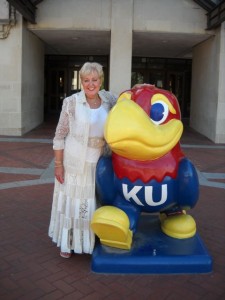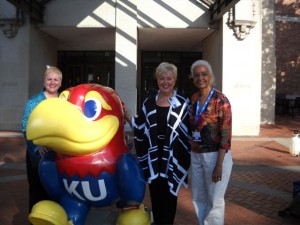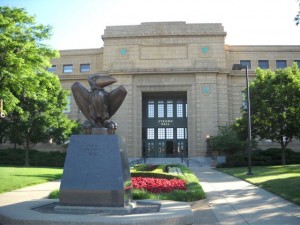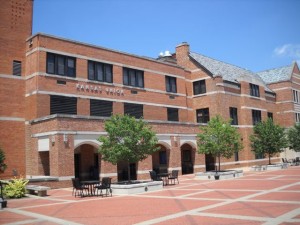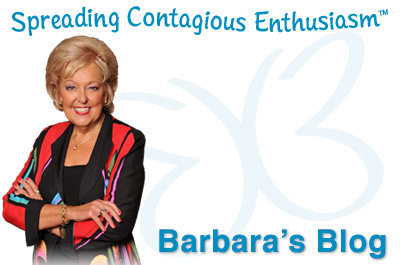A Lifelong Learning Adventure
Last week I was privileged to take part in a wonderful life learning experience – a week of lectures and classes on the campus of KU taught by top college professors to a group of educated and interesting adults. The professors who taught each of the nearly 75 different 90 minute sessions were all volunteers who had to “apply” to be a part of the week. The Dean of the College of Liberal Arts and Sciences, for example, good-naturedly told us in his address that he wanted to teach a class but had gotten turned down! He shared that the goal of Liberal Arts is “To understand what it means to be human,” and that was certainly the purpose of this week.
It was interesting that the professors all week told us how much they were enjoying us as an audience – we came on time, listened, asked insightful questions, and did not sit texting on our cellphones! 😉 . Interestingly, they nearly all talked about the “silver tsunami” –that the % of people over age 65 will double in the next two years and the implications that will have for our society.
We individually ahead of time planned our “curriculum” which consisted of choices from diverse areas of learning, including politics, religion, science, education, life skills, film, history, and art. We were each able to experience fifteen 90 minute classes and several lectures and addresses to the entire group as well as walking, museum, and bus tours.
The full group presentations during the week included addresses from the Dean of the College of Liberal Arts and Sciences, the Chancellor of the University, a film screening of “The Only Good Indian,” Steve Hawley, an astronaut from NASA (participated in 5 shuttle missions) who spoke on “Inside Space,” a session on “Flamenco for Everyone,” and a presentation on “From the Golden Valley to Silicon Valley-A New Era of Cancer Treatment” from the Executive Chairman of Genomic Health.
This was my schedule of classes with several of the major learnings from each:
“The Psychological Toxicity of Modern Life”—Stephen Hardi
• 99.9% of our existence as a species was as Hunter –Gatherers. Our bodies were designed for a different time and place. Diseases of modernity include – Obesity, Diabetes, Hardening of the Arteries, Asthma, Fibromyalgia, Cancer, Depression.
• 70% of adults are clinically overweight. Today our appetites are calibrated to sugar, salt, fat and starch rather than the natural foods of our ancestors.
• 50% of all American adults will be diagnosed with a serious mental illness at some time in their lives. Depression can cause brain damage because cortisol, the chemical produced by depression, turns off brain growth. Chronic stress is toxic!
• The average American teenager spends 7 ½ hours a day in front of a screen, not counting the 1 ½ hours of texting. Today’s lifestyle is an environmental mutation. Depression is 10X lower in the Amish society, for example, because of their simpler lifestyle.
• BCNF is the brain growth hormone. It can grow new connections and repair brain damage at any age. Exercise stimulates BCNF – 40 minutes of brisk walking 3X a week is recommended. A couch potato measures 10 – 15 years older for biological age while regular exercisers measure 10 – 15 years younger.
• Single best current marker for heart disease – CRP, a blood test that measures inflammation. Meta-analysis pooling all studies proves that regular aerobic exercise is better than a stent after a heart attack.
• 80-90% of Americans get sub-optimum levels of vitamin D3. It is an anti-inflammatory that regulates our immune system. We NEED sunlight!
• Ways to combat this toxicity:
Physical Exercise—single most important medicine
Omega-3 Fats
Sunlight
Social Connection
Healthy Sleep
Engaging (anti-ruminative) Activity
• His book is “The Depression Cure” by Stephen Hardi
(Note: This was one of my favorite sessions!)

The Campanile which is the most famous landmark at KU. You walk through it and down the hill at graduation.
“Everything You Wanted to Know About GDP”—Joshua Rosenbloom
• Gross Domestic Product = An ESTIMATE of total value of goods and services in an economy; market value of all final goods and services produced within a country during a specified period. Monetary quantity ($) and Flow ($ spent per unit of time)
US GDP 2009 — $14.26 Trillion
US GDP per capita — $46,400 (average income)
China GDP 2009 — $8.79 Trillion ($4.81 Trillion official US exchange rate)
China GDP per capita — $6600 ($3300 Us exchange rate)
• REAL GDP – Physical production plus Prices
• Genuine Progress Indicator (GPI) –Relates GDP to measure of well-being. Our GDP is going up, but NOT the wellness of the individual person in America!
• GDP—How much is produced? GDI – How does production relate to welfare?
“Stuff Accumulates: Managing and Downsizing Possessions”—Dave Ekerdt
• This session was particularly challenging for me as even after my move to Florida five years ago and extreme downsizing, I am now “bursting at the seams” in my 1800 square foot condo! 😉
• He discussed the Life Cycle of THINGS – Extraction, Production, Distribution, Possession, Disposal.
• Another new concept was the LABOR of possessions, that everything we possess has a packet of labor to keep it – placed, stored, cleaned, maintained, emotional ties. “Stuff is a lot of trouble!” Sometimes we tolerate, resent or even hate our things!.
• Possessions are fundamental to people’s identity : “I am what I have.” Jean –Paul Sartre. “Having” is a way of “Being” in the world. It takes courage to get rid of things – Who am I going to be in the future? Giving things away, however, can be an act of resilience to be able to live more freely.
• 9 possession motives (WHY we keep things)
Things seem useful.
Things are worth money.
Things give pleasure.
Things represent us.
Things conjure the future.
Social reciprocity to givers.
Responsibility to forbears.
Conservation is a virtue.
We keep because we can.
• Freecycle.org – places where you can offer things to people who would value or need them. One of my realizations is that things I am saving for my family they may not even want!
“The Promise of Personalized Medicine”- Stuart Macdonald
• This session, like the last one of the week, talked about mapping individual human genomes to target personalized disease susceptibility and individual drug response.
• SNP’s = any position in the genome that is a variant.
• Only 1% of our DNA is important. The rest is “junk DNA.” Geneitc Transmission from our parents can contain risk factors for disease or bad copies of a gene. There may even be genes for addictive behavior. Mapping these variants will lead to greater understanding of risk factors and treatment.
• Both genetic and environmental factors (Gender, Age, Diet, Physical environment) affect disease.
• The genome is fluid.
“Looking for the Knowledge Frontier”—Leonard Krishtalka
• The professor for this session is the director of the Biodiversity Institute at KU which has been named the best in the country. He showed a cartoon that I loved. One person asked a guru, “What is the meaning of life?” The guru answered, “I don’t know. The computers are down!”
• His premise was that there should be one culture of the Sciences, Arts and Humanities to cooperate to understand systems, both natural and human, to:
1. Create sustainable natural and human systems
2. Resolve human conflict
Science vs. Religion
Tribalism
Ethnic pride vs. Ethnic cleansing
He observed that Science alone can’t save us!
• He would like to see a Global Systems Observatory – a knowledge server for society made up of all these disciplines.
“Generational Differences”—Tracy Russo
• Shared the characteristics of each of the generational groups: Veterans/Builders (born before 1946); Baby Boomers (1946- 1964): Generation X (1964 – 1977); Generation Y ( 1978- 1990); Millenials (1991 to present) according to:
Defining Events
Icons: people, places things
(This was fun and brought back many memories.)
• Changes influencing Generations:
Educational System
Connectivity through Technology
Personal Security
Family Arrangement
Ideas About Time
Communication Norms
• Then she looked at how to work together according to their Assets, Liabilities and Sources of Conflict.
• Bottom line are things that we all want as human beings: To be….Respected, Recognized, and Remembered; Coached, Consulted, and Connected.
• Best ways to integrate the generations: FOCUS ON THE TASK and COMMUNICATE.
“Quantrill’s Raid Bus Tour”
“Science and Religion”- James Woelfel
• This session focused on the four models of the relationship between science and religion:
Conflict – Where they disagree, they are simply incompatible and in conflict.
Independence – They perform completely different functions in human life and thought , each with its own autonomous ways of speaking.
Dialogue — Theologians seeking to engage with scientists and philosophers of science on general issues of respective knowledge-claims (mostly one-sided, intramural discussion).
Integration – Those who believe it’s possible to work out a
Synthesis between scientific and theological knowledge.
• He particularly focused on the debate between Creationism and Evolution and is hopeful that integration can occur one day.
“Latin America Through Hollywood’s Eyes”
• This was a much lighter, fun session. We looked through clips of Hollywood films at how stereotypes of Latin American people changed after the “Good Neighbor Policy” in 1933 when the government teamed up with Hollywood (a FIRST???) to send cultural representatives , including Walt Disney and Orson Wells, to Latin American countries to better understand their culture. Now I want to rent several of those movies!
“Dangerous Genes: The Molecular Basis for Cancer”—Rob Weaver
• This was a very complicated session, but the professor did a wonderful job of simplifying the ideas with his powerpoint and lecture. He answered 3 questions: What is cancer? What is molecular biology? What role does molecular biology play in cancer?
• Definition of cancer is a malfunction of the control systems that regulate cell growth and death. McGrady calls it “A savage cell that somehow corrupts the forces that normally protect the body.”
• Proteins control cell growth and death. Oncogenes produce proteins (oncoproteins) that promote growth. Tumor suppressors = proteins that inhibit growth or promote cell death.
• Molecular biology is the study of the production of proteins using instructions written in the genes. When there is a mutation in the gene during replication or from damage, then cancer can result.
• Most mutations that cause cancer are NOT inherited. WHO and American Cancer Society estimate that 60 – 90% of all cancer cases are due to environmental factors.
• The cancer death rate has dropped nearly 20% in the last 15 years. GLEEVEC is a new drug from Novartis that targets the active site of the mutation to inhibit the protein enzyme in CML, so this field is producing amazing results through its research.
“Stories from 7 Presidential Campaigns”—Bill Lacy
• For this session we drove to the Dole Institute, a lovely facility with a very interesting museum of all of Bob Dole’s papers and historical information. Bill Lacy, the Executive Director of the Institute, has been involved in seven different Presidential campaigns and shared behind-the scenes stories of these experiences.
“Using Art for Creative Research”—Susan Earle
• This session was held at the Spencer Museum of Art where we had a tour as well as an interesting session on how to determine whether a work of art is authentic or not.
“Symbolic DNA of Terrorism”—Robin Rowland
Rowland feels Terrorism is fundamentally rhetorical – “Kill people to send an idea”:
• Terrorism is overwhelmingly from religious groups.
• Deterrence doesn’t work with terrorists.
• There are an infinite number of soft targets in the West. American born terrorist attacks are new – his biggest concern.
• A radicalized Islamic community in the West makes terrorism inevitable.
• Maintaining support within the Islamic community will deter terrorism.
• Kinetic solutions (bullets, bombs) – use rarely, but when you do, make them overwhelming. When we are strong, we risk creating more terrorists than we kill, but when we are weak, it emboldens the terrorists – double bind.
• Key is to win WAR OF IDEAS.
• Characteristics of terrorist groups – Always based on a mythic ideological system: Defines good and evil; shapes how they live their lives; distorted world view.
• DNA
D = Denial: Poverty is NOT the cause but loss of denied identity; emasculation, alienation, powerlessness, humiliation –causes them to take role of martyrs = anger and violence
N = Negation: Define enemies as totally evil, negate them, blame them for all woes. Create polarization—radical simplicity is essential; any action is justified.
A = Affirmation: Strong sense of new identity – find sense of self and meaning; return to purity of the way it was = Islamic Golden Age. Justifies anything – see it as God’s will.
• We have to win the war of rhetoric (battle of hearts and minds):
1. We should at all time demonstrate RESPECT for Islam and their culture.
2. We need to do everything we can to create a sense of SHARED IDENTITY – they are human beings, just like us (“Three Cups of Tea”). For example, our tsunami relief to Muslim countries undercut the Taliban.
3. We need to tell a BETTER STORY than they do—in the West we offer a free society with equal justice.
4. We need to support/aid every Islamic group to rectify these myths (find other interpretations of Islam).
• I.e., We respect you, your faith, we are alike as humans, and we all want equal justice for all.
• The best news is that he has given this presentation to many high level military leaders and he days that both McCrystal and Petraeus “get it!”
“Genomics and the Future of Personalized Medicine”—Randy Scott
• This session was presented by the founder of Genomic Health, an organization that does research and develops diagnostic tests for cancer patients. They are currently able to map the genome of each individual so that they can classify patients by the molecular aspects of disease, not physical. This will improve the quality or treatment solutions as they move from drug centric to diagnostic centric.
• For example, cancer drugs work only about 20% of the time. They have just found that 83% of node negative breast cancer patients do not need chemotherapy, and only about 4% with the most aggressive cases actually benefit from the drugs. A diagnostic test to map the genome (Oncotpye DX) costs about $4000 (and in 5 years will probably come down to about $1000) while the chemotherapy costs about $30,000.
• Questions to be answered from this diagnosis:
Will my cancer spread?
Do I need chemo after surgery?
Are there any new drugs targeted for my type of cancer?
• The mapping starts with DNA (genome = master blueprint) to RNA (transcriptome = copies of the master blueprint) to Protein (proteome = multiple “buildings”, 25,000 different ones). The proteins are what mutate and are different in each individual and it is the presence, absence, or combination of them that cause disease. He said he never imagined that this could be done in his lifetime and we are now doing it! Eventually, data could be stored from many individuals which would lead to better understanding and treating each individual’s disease.
• He described the best future career is to be a Biostatistician and that Biological computing will be the leading driver of data storage as they are able map each individual’s genome.
“Use It Or Lose It”–Susan Kemper
• Rates of cognitive decline were the same with aging regardless of education and IQ (Berlin Study),
• There is a slower rate of decline for those who are more active (Priests Study). The more active you are, the less likely you will be to get dementia or it will develop at a later age.
• Cognitive engagement (brain gym kinds of exercises) helps but only for vocabulary (Salthouse Study).
• She ranked a list of activities and their relationship to cognitive development. Interestingly, watching TV was at the bottom of the list, and the very WORST for your brain is watching baseball on TV – not a good thing for fans! 😉
• Bottom line—The only proven things that make a difference are EXERCISE and DIET!
Please, as you read this, remember that I am just a learner, not an expert, and these learnings are simply taken from my notes. However, I came away stretched, challenged, and inspired to learn even more about several of these topics. Most of all, it was a chance for me to learn something other than about my business and areas of expertise, and I am SURE I grew some new brain cells as a result!
Next year’s dates are June 6-10, and you can learn more about it a www.minicollege.ku.edu or call 785-864-1767. I will be there for sure!
If you want to learn more about Barbara’s work and life, go to www.barbaraglanz.com
